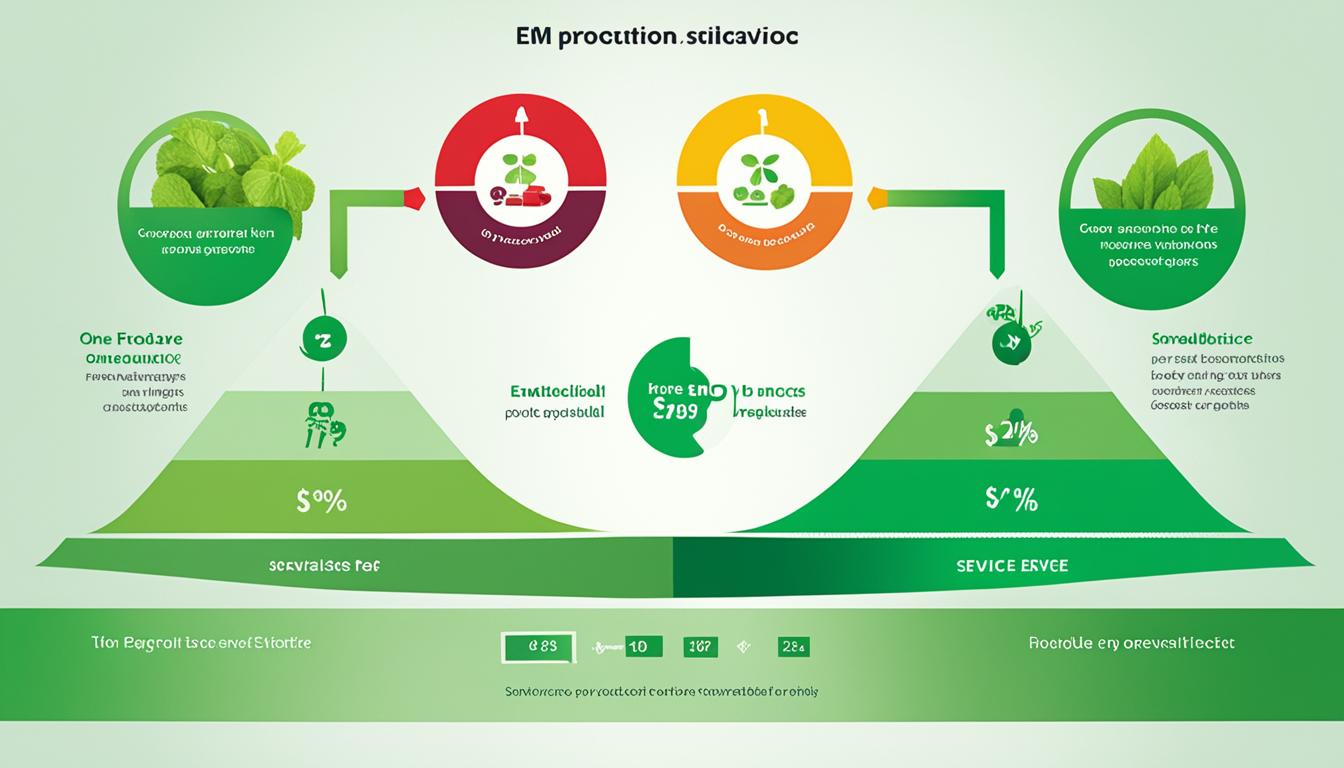As digital payment solutions continue to evolve and shape the way we conduct transactions, it’s essential for companies to implement effective marketing strategies to stay ahead of the curve. In this case study, we will delve into Google Pay’s marketing strategy and explore how it has positioned itself as a leader in the online payment industry.
Google Pay, formerly known as Tez, has quickly gained a large user base and become one of the top digital wallets in the market. With the rising demand for contactless payments and the increasing popularity of e-commerce, Google Pay aims to drive innovation and revolutionize the online payment landscape.
Let’s take a closer look at Google Pay’s marketing approach and how it optimizes its campaigns to engage users and promote its payment app effectively.
Key Takeaways:
- Google Pay has established itself as a leading online payment app through its effective marketing strategy.
- Contactless payments and e-commerce innovation are central to Google Pay’s marketing approach.
- Google Pay’s marketing campaigns are optimized to engage users and drive app adoption.
- The online payment industry is highly competitive, but Google Pay’s strong user base gives it a competitive edge.
- Google Pay is well-positioned to leverage the growing trend of mobile wallet usage and drive digital payment solutions in the future.
About Google Pay
Google Pay, formerly known as Tez, is a popular online payment app and digital wallet that was founded in 2011. With its user-friendly interface and innovative features, Google Pay has become a major player in the online payment industry. Users can make contactless payments and purchases through their Android phones, tablets, and smartwatches, providing them with a convenient and secure way to transact online.
Google Pay has amassed an impressive user base of over 220 million users and is accepted by 10 million merchants across 19,000 pin codes. This widespread acceptance and usage make Google Pay one of the most widely used online payment platforms in the market. Whether it’s paying for groceries, shopping online, or splitting bills with friends, Google Pay offers a seamless and efficient payment experience.
Google Pay’s success can be attributed to its dedication to user satisfaction and continuous innovation. By constantly updating its features and enhancing its security measures, Google Pay ensures that users can trust the platform with their financial transactions. The integration of contactless payments and the ability to make purchases online with just a few taps have made Google Pay a preferred choice for millions of users worldwide.
Key Features of Google Pay
- Contactless payments through Android devices
- Seamless online purchases
- Secure and encrypted transactions
- Easy integration with various merchants
- Convenient bill splitting and peer-to-peer transfers
- Ability to store loyalty cards and boarding passes digitally
With its extensive user base, secure payment infrastructure, and continuous efforts to provide an exceptional user experience, Google Pay is set to remain a dominant player in the digital wallet industry. As online transactions continue to rise, Google Pay will continue to revolutionize the way we make payments and usher in a new era of convenient and secure digital payments.
Google Pay Usage Statistics
In 2021, Google Pay emerged as the leader in the UPI market, capturing a significant market share of over 37.5%. The app facilitated transactions worth INR 2.74 Lakh Cr, solidifying its position as a prominent player in the digital wallet and online payment app space. With a wide user base of more than 220 million users, Google Pay has successfully penetrated the market and gained the trust of millions for its seamless and secure mobile transactions.
Furthermore, Google Pay has built strong partnerships with over 10 million merchants across 19,000 pin codes, enabling users to make payments conveniently and effortlessly. The platform’s widespread acceptance among merchants has contributed to its popularity and adoption by users across various industries and sectors.
As the leading mobile payment app, Google Pay is accepted by nearly 800,000 websites, making it a versatile and widely accessible payment option for users. Its presence in numerous online platforms and businesses further solidifies its position as a go-to digital wallet for millions of individuals.
Approximately 20% of all mobile transactions in the market can be attributed to Google Pay. With its user-friendly interface, comprehensive security measures, and seamless integration with various services, Google Pay has become the preferred choice for mobile transactions, providing a convenient and hassle-free payment experience to users.
By continuously investing in technological advancements and user-centric features, Google Pay aims to further strengthen its market presence and drive the growth of the digital payment ecosystem.
| Year | Market Share | Total Transactions (INR) | User Base | Merchants |
|---|---|---|---|---|
| 2021 | 37.5% | 2.74 Lakh Cr | 220 million | 10 million |
| 2020 | 33.2% | 2.15 Lakh Cr | 180 million | 8 million |
| 2019 | 29.9% | 1.85 Lakh Cr | 140 million | 6 million |
Google Pay Business Model
Google Pay operates as an online payment platform, offering users a convenient and secure way to make transactions. The platform’s revenue model primarily revolves around transaction-based charges, ensuring that they generate income through every payment made through their platform.
Merchants and banks are charged fees for utilizing Google Pay’s services for online and in-app payments. These transaction fees contribute to the platform’s revenue sources, allowing them to sustain and enhance their services over time.
In addition to transaction fees, Google Pay generates revenue through various other sources. One of the significant sources is advertisements. By displaying targeted ads within the app, Google Pay reaches a large user base, providing businesses with opportunities for effective advertising.
Furthermore, Google Pay leverages product offers to generate revenue. By partnering with merchants and service providers, they can offer exclusive deals, discounts, and cashbacks to users. This not only increases their revenue but also enhances the user experience and encourages more frequent usage.
Another noteworthy source of revenue for Google Pay is the collection and utilization of user data. As users engage with the platform, Google Pay gathers valuable insights into their spending habits, preferences, and behavior. This data can then be utilized for personalized marketing campaigns, targeted advertisements, and enhancing the overall user experience.
It’s worth noting that Google Pay does not charge users for utilizing its services. In fact, the platform offers added convenience by allowing users to send money to banks for free. This user-centric approach has contributed to Google Pay’s large user base and widespread adoption.
Overall, Google Pay’s business model is centered around transaction-based charges from merchants and banks, supplemented by revenue sources such as advertisements, product offers, and the collection and utilization of user data. This model ensures the sustainability and continuous innovation of the platform while providing users with a seamless and rewarding payment experience.
Challenges Faced by Google Pay
Like any online payment app, Google Pay has encountered its fair share of challenges. Technical glitches and user complaints have been some of the hurdles faced by this popular digital wallet. One of the notable issues that users have experienced is the occasional removal of bank accounts without prior notice, leading to frustration and concerns about the security of their funds. These technical glitches and related inconveniences have resulted in user complaints, highlighting the importance of seamless and reliable service in the digital payment industry.
Despite these challenges, Google Pay has demonstrated its commitment to resolving issues promptly and effectively. With a dedicated team of experts, the company has successfully addressed technical glitches and improved the overall user experience. Making customer satisfaction a priority, Google Pay has maintained its reputation as a trustworthy and user-friendly payment platform.
Growth of Google Pay
Google Pay has experienced significant growth over the years, establishing itself as one of the leading mobile payment apps in the industry. With its user-friendly interface and innovative features, Google Pay has managed to attract millions of users and merchants, solidifying its position in the market.
As the digital payment landscape continues to evolve, Google Pay has been at the forefront of driving the adoption of mobile payment solutions. Its seamless integration with Android devices and extensive network of partners have contributed to its widespread popularity.
Despite facing competition from other payment apps such as PhonePe, Paytm, Amazon Pay, and Stripe, Google Pay has managed to maintain its dominant position. Through continuous innovation and strategic partnerships, Google Pay has been able to stay ahead of its competitors and offer unique payment solutions to its users.
Key Factors Driving Google Pay’s Growth:
- Large User Base: Google Pay has successfully attracted millions of users, leveraging its integration with Android devices and its widespread acceptance across various online platforms.
- Merchant Network: The platform’s extensive network of merchants has made it a preferred choice for businesses looking to accept digital payments.
- Easy-to-Use Interface: Google Pay’s intuitive and simple interface has made it accessible to users of all demographics, further contributing to its growth.
- Continuous Innovation: Google Pay consistently introduces new features and enhancements to meet the evolving needs of its users, ensuring an engaging and convenient payment experience.
| Year | Google Pay Users (in millions) | Number of Merchants |
|---|---|---|
| 2017 | 10 | 1 million |
| 2018 | 50 | 5 million |
| 2019 | 100 | 8 million |
| 2020 | 150 | 10 million |
| 2021 | 220 | 12 million |
As shown in the table above, Google Pay has witnessed substantial growth in terms of its user base and the number of merchants onboarded. This growth trend is indicative of the platform’s increasing popularity and acceptance among consumers and businesses alike.
Looking ahead, Google Pay is expected to continue its growth trajectory by further expanding its user base, strengthening its merchant network, and introducing innovative payment solutions. With its strong foothold in the industry and continuous focus on user experience, Google Pay is well-equipped to navigate the competitive landscape and remain a dominant player in the online payment ecosystem.
Google Pay Competitors
Google Pay faces competition from various payment apps, including PhonePe, Paytm, Amazon Pay, and Stripe. Each of these apps offers its own set of features and functionality, catering to different user preferences. However, Google Pay’s strong user base and reputation give it a competitive edge in the market.
When it comes to digital payment solutions, there are several players vying for the top spot in the industry. Google Pay, PhonePe, Paytm, Amazon Pay, and Stripe are among the leading names in the market.
PhonePe is a popular payment app in India, offering a seamless and secure way to make online payments. With features like UPI transactions and bill payments, PhonePe has gained a significant user base in a short period.
Paytm is another major player in the digital payment space, known for its diverse range of services such as mobile recharges, bill payments, and QR code-based transactions. With millions of users and a strong presence in the market, Paytm poses a formidable competition to Google Pay.
Amazon Pay, backed by the global e-commerce giant Amazon, offers a convenient and reliable payment option for customers. With its integration into the Amazon platform and its focus on providing a seamless shopping experience, Amazon Pay has gained traction among online shoppers.
Stripe, on the other hand, is a leading global payment platform that caters to businesses of all sizes. With its robust set of payment solutions and developer-friendly tools, Stripe has become a preferred choice for many businesses looking to accept online payments.
Despite the competition, Google Pay maintains its competitive edge in the market. Its large user base and reputation as a reliable payment app have contributed to its success. Additionally, Google Pay continues to innovate and enhance its services to meet the evolving needs of its users.
Next, let’s explore some key features and differences between these payment apps in the following table:
| Payment App | Key Features | User Base | Market Presence |
|---|---|---|---|
| Google Pay | Contactless payments, online transactions | 220 million+ | Global presence |
| PhonePe | UPI transactions, bill payments | Over 300 million | India-focused |
| Paytm | Mobile recharges, bill payments, retail payments | Over 450 million | India-focused |
| Amazon Pay | Secure payments on Amazon, bill payments | Millions of customers | Global presence |
| Stripe | Payment processing for businesses, developer tools | Millions of businesses | Global presence |
Future Plans for Google Pay
Google Pay has ambitious plans to further expand its offerings and transform into a comprehensive online wallet. With a focus on innovation and user convenience, Google aims to introduce several new features to enhance the payment experience.
1. Digital Cards for Storing Crypto Assets
As the popularity of cryptocurrencies continues to rise, Google plans to introduce digital cards within Google Pay. These cards will enable users to securely store their crypto assets and seamlessly manage their digital currencies within the app.
2. Payments in Standard Currencies
Not limiting itself to digital currencies, Google Pay aims to facilitate payments in standard currencies as well. Users will be able to make payments using their Google Pay accounts, providing a more versatile and convenient payment solution.
3. Enhanced Shopping Experience
Google aims to integrate Google Pay’s payment features directly into its shopping services. With personalized discounts and customer loyalty cards, users will have the ability to unlock exclusive offers and enjoy a seamless online shopping experience.
Furthermore, Google plans to incorporate advanced search capabilities within Google Pay, enabling users to discover products and services that align with their preferences and interests.
With these upcoming features, Google Pay is poised to become a comprehensive online wallet, offering a wide range of payment options and personalized benefits to its users.
Google’s Marketing Strategies
Google, a leading technology company, has implemented a range of marketing strategies to solidify its position in the industry. Through a user-centric approach and continuous innovation, Google has successfully achieved widespread recognition and success. One of their key strategies is a focus on delivering an exceptional user experience.
Google’s commitment to user-centricity has shaped their marketing initiatives. By understanding and meeting the needs of their users, Google has been able to attract a loyal customer base. Their marketing campaigns are designed to provide value to users and enhance their overall experience. From personalized search results to tailored ads, Google strives to deliver relevant content that aligns with user preferences.
Another pillar of Google’s marketing strategy is product diversification. They have expanded their product offerings to cater to different target audiences and capture various markets. From search engines and productivity tools to cloud services and smart devices, Google offers a wide range of products that meet the diverse needs of consumers and businesses alike.
In addition to product diversification, Google has maintained brand consistency throughout its various offerings. With a minimalist design and intuitive user interface, Google products feature a cohesive and recognizable brand identity. This consistency helps to build trust and loyalty among users, reinforcing Google’s position as a leading technology brand.
Furthermore, Google’s ethical practices and commitment to user privacy contribute to their marketing strategies. In an era where data protection and privacy are paramount, Google has implemented strict policies and measures to safeguard user information. By prioritizing ethical practices, Google enhances user trust and reinforces its brand reputation.
Overall, Google’s marketing strategies revolve around a user-centric approach, product diversification, and brand consistency. Through their continuous focus on delivering value to users and maintaining a strong brand presence, Google has established itself as a leader in the technology industry.
| Marketing Strategies | Description |
|---|---|
| User-centric approach | Google prioritizes user needs and strives to deliver an exceptional user experience through personalized content and tailored marketing campaigns. |
| Product diversification | Google offers a diverse range of products to cater to different target audiences and capture various markets. |
| Brand consistency | Google maintains a consistent brand identity across its product offerings, reinforcing user trust and loyalty. |
| Ethical practices | Google prioritizes user privacy and implements strict policies to protect user information and maintain ethical standards. |
Google’s Impact on the Digital Age
Google has revolutionized the digital landscape, leaving a lasting impact on online marketing, information retrieval, technological innovation, and the global economy. Through its relentless pursuit of providing relevant and useful search results, Google has transformed the way we access and utilize information.
With its powerful search engine algorithms and comprehensive indexing, Google has become the go-to platform for individuals, businesses, and researchers seeking information. Its commitment to delivering accurate and reliable search results has significantly contributed to the advancement of online marketing strategies.
Online Marketing:
Google’s dominance in the search engine market has made it an essential player in online marketing. Businesses now utilize search engine optimization (SEO) techniques to improve their visibility on Google’s search results pages, resulting in increased website traffic and brand exposure. By targeting specific keywords and optimizing their online presence, businesses can effectively reach their target audience and drive conversions.
Additionally, Google Ads provides businesses with a powerful platform to advertise their products and services. By utilizing Google’s targeted advertising capabilities, businesses can display relevant ads to users who are actively searching for specific products or services. This targeted approach enhances the efficiency and effectiveness of online advertising campaigns.
Information Retrieval:
Google’s search engine is synonymous with information retrieval. By continuously evolving and refining its search algorithms, Google has made it easier for individuals to find relevant and accurate information quickly. Whether searching for answers to complex questions or conducting research for academic purposes, Google’s search engine has become a trusted source of information.
Furthermore, Google’s commitment to providing snippets, featured snippets, and Knowledge Graphs has enhanced the user experience by offering concise and immediate answers to queries. This feature-rich approach to information retrieval has transformed the way we seek and interact with information online.
Technological Innovation:
Google has been at the forefront of technological innovation, driving advancements in various fields. From artificial intelligence and machine learning to virtual reality and autonomous vehicles, Google’s commitment to pushing boundaries has resulted in groundbreaking technological advancements.
Through initiatives such as Google X, the company’s research and development division, Google has fostered an environment of creativity and innovation. This approach has led to the development of cutting-edge technologies that have the potential to shape the future across industries.
Global Economy:
Google’s impact on the global economy cannot be underestimated. As a technology giant, Google has created numerous opportunities for businesses, entrepreneurs, and individuals alike. The availability of online advertising platforms, such as Google Ads, has enabled businesses to reach a global audience and expand their customer base.
Furthermore, Google’s suite of productivity tools, including Google Workspace, has transformed the way businesses operate. By providing cloud-based collaboration and communication solutions, Google has facilitated seamless global partnerships and remote work, leading to increased productivity and efficiency.
Overall, Google’s influence on the digital age extends far beyond its role as a search engine. Its impact on online marketing, information retrieval, technological innovation, and the global economy is undeniable. As Google continues to innovate and evolve, its influence on the digital landscape will undoubtedly shape the future of the digital age.
Conclusion
Google Pay’s marketing strategy has been a game-changer in the online payment industry. Through its user-centric approach, focus on innovation, and commitment to providing a seamless user experience, Google Pay has emerged as a leader in the digital payment solutions market. The success of Google Pay can be attributed to its effective marketing tactics, which have helped it gain a significant market share and become a preferred choice for millions of users.
As seen in this case study, Google Pay has effectively leveraged its marketing strategy to drive adoption and engagement. By continuously introducing new features and optimizing its campaigns, Google Pay has maintained its position as a preferred payment app for both consumers and merchants. Its emphasis on contactless payments and investment in e-commerce innovation have further solidified its position in the industry.
Looking ahead, Google Pay is poised for continued growth and success. With the increasing popularity of mobile payment options, Google Pay is well-positioned to meet the growing demand for digital payment solutions. By staying true to its core values of user-centricity and innovation, Google Pay will likely continue to shape the future of the online payment landscape.







